
A lichen is a composite organism that arises from algae or cyanobacteria living among filaments of multiple fungi species in a mutualistic relationship. Lichens have properties different from those of their component organisms. They come in many colors, sizes, and forms and are sometimes plant-like, but are not plants. They may have tiny, leafless branches (fruticose); flat leaf-like structures (foliose); grow crust-like, adhering tightly to a surface (substrate) like a thick coat of paint (crustose); have a powder-like appearance (leprose); or other growth forms.

Cladonia rangiferina, also known as reindeer cup lichen, reindeer lichen or grey reindeer lichen, is a light-colored fruticose, cup lichen species in the family Cladoniaceae. It grows in both hot and cold climates in well-drained, open environments. Found primarily in areas of alpine tundra, it is extremely cold-hardy.

Cladonia is a genus of moss-like lichens in the family Cladoniaceae. They are the primary food source for reindeer/caribou. Cladonia species are of economic importance to reindeer-herders, such as the Sami in Scandinavia or the Nenets in Russia. Antibiotic compounds are extracted from some species to create antibiotic cream. The light green species Cladonia stellaris is used in flower decorations.

The Cladoniaceae are a family of lichenized fungi in the order Lecanorales. It is one of the largest families of lichen-forming fungi, with about 560 species distributed amongst 17 genera. The reindeer moss and cup lichens (Cladonia) belong to this family. The latter genus, which comprises about 500 species, forms a major part of the diet of large mammals in taiga and tundra ecosystems. Many Cladoniaceae lichens grow on soil, but other can use decaying wood, tree trunks, and, in a few instances, rocks as their substrate. They grow in places with high humidity, and cannot tolerate aridity.

A prothallus, or prothallium, is usually the gametophyte stage in the life of a fern or other pteridophyte. Occasionally the term is also used to describe the young gametophyte of a liverwort or peat moss as well. In lichens it refers to the region of the thallus that is free of algae.
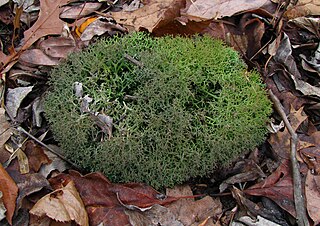
Cladonia furcata or the many-forked cup lichen is a species cup lichen in the family Cladoniaceae. It has an intermediate to tolerant air pollution sensitivity. Extracts of this species have been shown to kill leukemia cells in vitro, and may have possible value in the treatment of cancer.
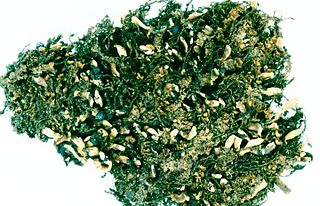
Cetradonia is a lichen genus in the family Cladoniaceae. A monotypic genus, Cetradonia contains the single species Cetradonia linearis. The genus was circumscribed in 2002 by Jiang-Chun Wei and Teuvo Ahti. The genus was once placed in the family Cetradoniaceae until that family was subsumed into the Cladoniaceae in 2006.
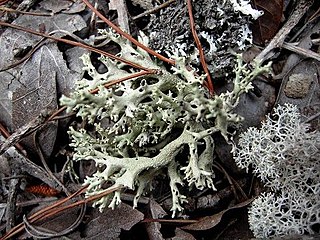
Cladonia perforata is a rare species of lichen known as Florida perforate cladonia and Florida perforate reindeer lichen. It is endemic to the state of Florida in the United States, where it is known from 16 populations in four widely separated areas of the state. It is native to a very specific type of Florida scrub habitat which is increasingly rare and patchy due to habitat destruction, degradation, and fragmentation. In 1993 this was the first species of lichen to be federally listed as an endangered species of the United States.

Dibaeis baeomyces, commonly known as pink earth lichen, is a fruticose lichen belonging to the family Icmadophilaceae.
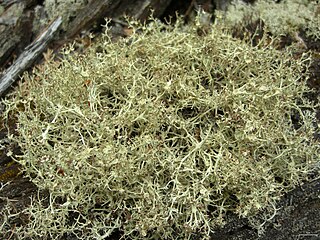
Cladonia amaurocraea, commonly known as the quill lichen or the quill cup lichen, is a species of fruticose, cup lichen in the Cladoniaceae family.
Cladonia wainioi or the Wainio's cup lichen is a species of cup lichen found in boreal and arctic regions of the Russian Far East and northern North America.

Cladonia sobolescens, commonly known as the peg lichen, is a species of fruticose lichen. It is found in temperate eastern North America and East Asia.

Cladonia subradiata is a widely distributed species of fruticose lichen in the family Cladoniaceae. It is found in Asia, Africa, Melanesia, Australia, New Zealand, and South, Central, and North America.

Cladonia coniocraea, commonly known as the common powderhorn or the powderhorn cup lichen, is a species of fruticose, cup lichen in the family Cladoniaceae. It was first described by Heinrich Gustav Flörke in 1821 under the name Cenomyce coniocraea, until Kurt Polycarp Joachim Sprengel reclassified it under the genus Cladonia in 1827.

Cladonia digitata, commonly known as the finger cup lichen, is a cup lichen species in the family Cladoniaceae.

Cladonia coccifera or madame's cup lichen is a species of fruticose, cup lichen in the family Cladoniaceae. It was first described by Swedish lichenologist Carl Linnaeus in his 1753 work Species Plantarum. German botanist Carl Ludwig Willdenow transferred it to the genus Cladonia in 1787. The lichen has apothecia and bright red pycnidia atop of yellowish to grey-green podetia that are 1–2 cm (0.4–0.8 in) high. The base of the thallus comprises rounded squamules (scales) with a yellow to orange-brown undersurface. It typically occurs on acidic peaty and sandy soils.

Cladonia squamosa or the dragon cup lichen is a species of cup lichen in the family Cladoniaceae.
Cladonia inflata is a rare species of terricolous (ground-dwelling) lichen in the family Cladoniaceae. Found in Bahia, Brazil, it was formally described as a new species in 2018 by lichenologists André Aptroot and Marcela Eugenia da Silva Cáceres. The type specimen was collected by the authors from Palmeiras, on the Mount of Pai Inácio, at an altitude between 1,050 and 1,140 m ; here the lichen was found growing on siliceous sandstone rock in a transitional forest. Cladonia inflata is only known to occur at the type locality, and is only known from the type specimen. At this location the lichen is conspicuous but not abundant, and forms extensive mats with many other Cladonia species, such as C. bahiana, C. clathrata, C. dissecta, C. divaricata, C. friabilis, C. furfuracea, C. metaminiata, C. miniata, C. obscurata, C. parvipes, C. pityrophylla, C. polyscypha, C. salmonea, C. secundana, and C. substellata. The lichen has a fruticose (bushy), mineral-grey thallus that consists of upright hollow podetia measuring about 4 to 7 cm high, atop a cushion up to 10 cm (4 in) in diameter. It contains the secondary compound fumarprotocetraric acid. The specific epithet inflata refers to the inflated thallus of the lichen.
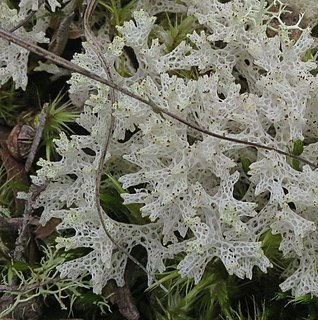
Pulchrocladia retipora, most commonly known as the coral lichen, is a species of fruticose lichen in the family Cladoniaceae. It occurs in Australasia and New Caledonia where it grows in coastal and alpine heathlands. The lichen features coral-like branches and subbranches with numerous netlike perforations. It is known by multiple names, with some sources referring to it by its synonym Cladia retipora, or the common name lace lichen.

Cladonia rei, commonly known as the wand lichen, is a species of ground-dwelling, fruticose lichen in the family Cladoniaceae. It is a widely distributed species, having been reported from Africa, Asia, Australasia, Europe, and North America. It is identified by its slightly dirty-colored, rough-surfaced, slender podetia that grow up to 9 cm (3.5 in) tall. Diagnostic characters of the lichen include the continuously sorediate, green-and-brown-mottled, podetia that taper upward to a point, while chemically, it contains homosekikaic and sekikaic acids. Its reduced capacity to bioaccumulate toxic heavy metals from its surroundings, as well as its ability to switch photobiont partners, allows the lichen to colonize and survive highly polluted habitats. There are several other Cladonia species that are somewhat similar in appearance, but can be distinguished either by subtle differences in morphology, or by the secondary chemicals they contain.



















